“Tororo” made by grating yamaimo (Japanese mountain yam), is a highly nutritious food containing various nutrients including dietary fiber. It can aid in digestion and absorption, help regulate blood sugar levels, and alleviate constipation and swelling. Additionally, there are different varieties of yamaimo, such as natural yam and nagaimo, each with different flavors and calorie content. Therefore, it’s important to understand these differences to enjoy tororo deliciously.
This article explains the nutrients and health benefits of tororo and the differences between yamaimo and nagaimo.
What is Tororo?
Grating raw yamaimo or nagaimo creates a dish known as tororo. People can enjoy tororo in various ways, such as adding it to soups like tororo soup, incorporating it into clear broths as tororo-ni, or pouring it over barley rice as barley tororo.
Additionally, when serving tororo over diced tuna, it goes by the name “yamakake,” which is often found in dishes like mountain-style soba or udon noodles. The act of pouring tororo in these dishes is called “yamakake.” Tororo boasts a rich content of essential vitamins and minerals, including vitamin B1, vitamin C, calcium, and potassium.
The yamaimo used to prepare tororo is referred to as “tororo-imo” (薯蕷藷、薯蕷芋). Although yamaimo and nagaimo are distinct species, they both belong to the yamaimo genus, and sometimes people collectively refer to them as yamaimo without differentiation.
About Yamaimo (山芋)
Yamaimo, belonging to the Dioscoreaceae family, is a perennial herbaceous vine known for its unique stickiness. People can only consume it in its raw form as a highly nutritious tuber. It earned the name “yamaimo” due to its habitat, originally growing wild in the mountains.
Yamaimo has a long history in Japan, with consumption dating back to the Jomon period. It is believed that cultivation of yamaimo began around the Kamakura to Muromachi periods. The nickname “mountain eel” is attributed to its nourishing and strengthening properties, which have been highly regarded throughout the years.
Types of Yamaimo
The Dioscoreaceae family includes various tubers that are referred to as yamaimo. However, it’s important to note that there isn’t a specific vegetable named “yamaimo.” The term “yamaimo” originated to distinguish wild mountain-growing tubers from the cultivated ones known as “satoimo.” People use the term “yamaimo” to differentiate between these two types of tubers.
Types of Yamaimo (Japanese Mountain Yam)
- Jinenjo (Natural Yam)
- Daijo
- Nagaimo (Long Yam)
- Ichouimo (Ginkgo Yam) / Yamatoimo (Yamato Yam)
Botanically, jinenjo is classified under the species Dioscorea japonica of the genus Dioscorea in the Dioscoreaceae family. Among them, nagaimo belongs to the “Dioscorea opposita complex,” and ichouimo falls under the “Dioscorea polystachya complex.” Let’s delve into each type to provide more detailed information.
Jinenjo (natural yam)
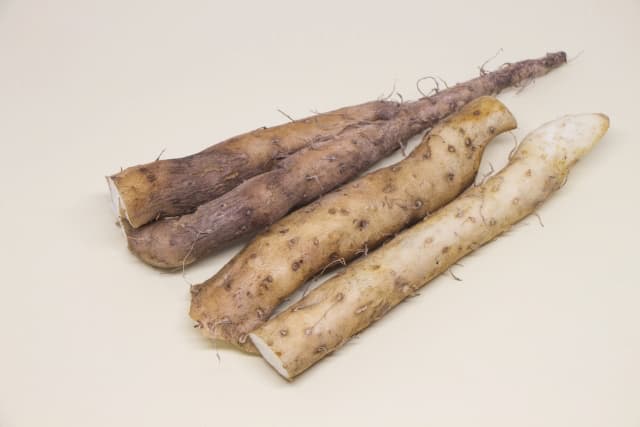
Natural yam, a native variety indigenous to Japan, has a slender shape, typically ranging from 60cm to 1m in length. Its distinctive characteristic is its strong stickiness, which results from its lower moisture content compared to other varieties. People often grate it and use it to make tororo. Additionally, cultivating natural yam takes approximately 3 to 4 years for harvest, and its excavation poses difficulties, making it rare to find in markets. Most of the natural yam available in markets today is cultivated.
Daijo
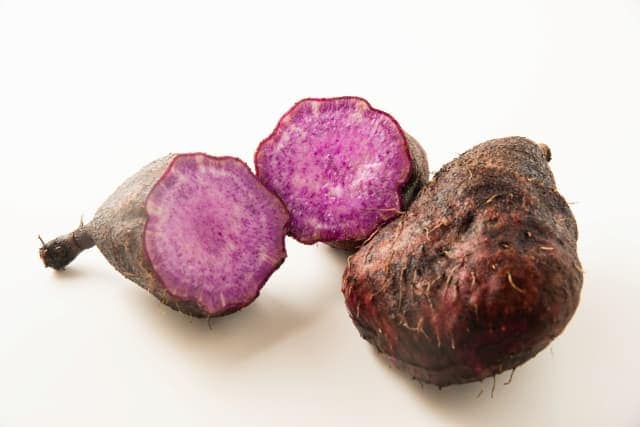
Daijo is a variety of yamaimo originating from Southeast Asia, also known as “Taiwan yamaimo” or “Okinawa yamaimo.” People consume it as a staple food in various regions, including Africa, tropical Asia, and Latin America. In Japan, farmers cultivate it in small quantities in certain areas, such as Okinawa and parts of southern Kyushu.
When grated, it exhibits a strong stickiness and a rich flavor. Additionally, there are both purple and white varieties. Grating the purple-skinned and purple-fleshed Daijo produces a light purple tororo with a distinct taste.
Nagaimo (Long Yam)
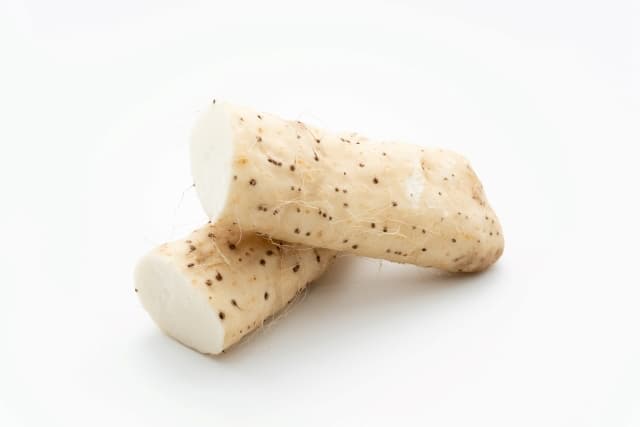
Among the yamaimo varieties, the elongated ones are known as “nagaimo.” Farmers cultivate this variety nationwide, and it holds the highest production volume. It is important to differentiate nagaimo from jinenjo (natural yam) as they have distinct methods of cultivation. While nagaimo is typically grown alongside other vegetables and tubers in farmland, jinenjo grows naturally.
In terms of characteristics, nagaimo stands out with its high moisture content and low stickiness. Instead of being grated into tororo, it is commonly sliced thinly for salads or pickled dishes. Alternatively, it can be cut into larger pieces for simmered dishes, allowing its texture to be fully appreciated and enjoyed.
Ichouimo (Ginkgo Yam)
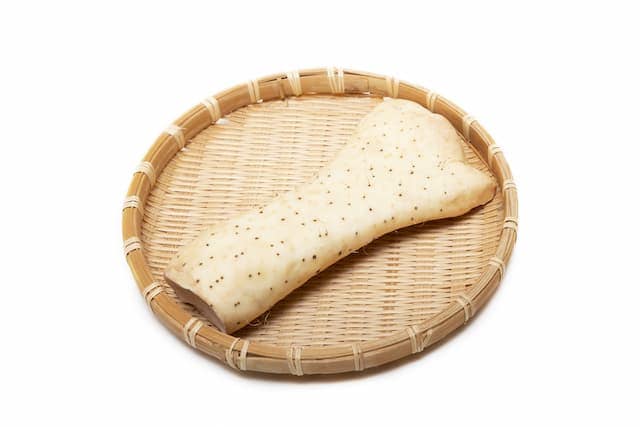
The elongated yamaimo varieties are commonly known as “nagaimo.” Farmers cultivate this variety nationwide, and it holds the highest production volume. People often mistake nagaimo for jinenjo (natural yam), but there is a difference in the way they are grown. Farmers typically cultivate nagaimo alongside other vegetables and tubers in farmland, while jinenjo grows naturally.
Nagaimo is notable for its high moisture content and low stickiness. Instead of grating it into tororo, it is more commonly sliced thinly for salads or pickled dishes. Alternatively, it can be cut into larger pieces for simmered dishes, allowing people to fully appreciate and enjoy its texture.
Recommended recipes from Tororo/ Yamaimo
Tororo Gohan
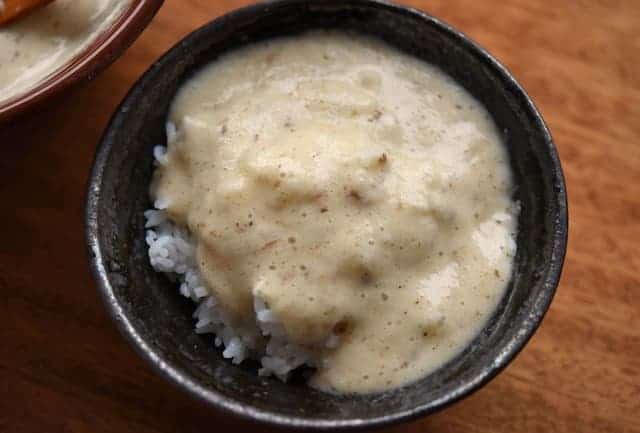
If you grate the Japanese yam directly in a mortar, you will get a smooth grated yam. Japanese yam is very sticky, so you need to season it, spread it with dashi soup, and eat it over barley rice. This is how you enjoy your Tororo Gohan.
Kimchi Tororo Yaki

This is a delicious snack with melty Japanese yam! To make this dish, you will need Kimchi, noodle soup, and egg white then add to Japanese yam which has already been pounded with a rolling pin, then placed in a heat-resistant dish and baked. You can use both egg yolk and egg white, so there’s no waste!
Mentaiko Tororo Harumaki

To make this delicious Harumaki, you need mix it with mentaiko and mentsuyu, and make it into spring rolls. It’s easy to make as it doesn’t require a lot of oil. It’s perfect as a side dish for rice or as a snack. If you lay down shiso leaves when rolling, the spring roll skin will not tear easily.
History
The origin of Jinenjo/ Yamaimo
The history of wild yam predates rice cultivation, mentioned in Japan’s oldest book, the Kojiki, as “Tokoro.” Originally distinct from Japanese yam, it was once bitter and inedible, yet sometimes consumed in the Tohoku region.
With time, methods evolved, like adding baking soda to remove bitterness, leading to dishes like “Tororo Meshi.” Even during the Edo period, figures like Shogun Tokugawa Ieyasu appreciated its health benefits. Its popularity grew, immortalized in literature by figures like Matsuo Basho. Today, traditions persist, with “Tororo Meshi” remaining a New Year’s custom in parts of Japan.
Recent advancements allow for wild yam cultivation in fields, ensuring its continued presence in culinary culture.
History of Tororo Jiru
“Tororo soup” has a long history, and is a specialty of Maruko (currently Maruko, Suruga, Shizuoka City), which was the 20th post town on the 53 stations of the Tokaido. It is popular among travelers as a dish that increases stamina.
It is said that it also appears in Ikku Jippensha’s novel “Tokaido–chu hizakurige“, Hiroshige Utagawa’s ukiyo-e “The Fifty-Three Stations of the Tokaido” and Matsuo Basho’s haiku “Ume-wakana Maruko no yado no tororojiru”
出典:農林水産省(https://shorturl.at/cemU1)
Health Benefits of Tororo
Assists in digestion and absorption
Tororo contains abundant amounts of starch-digesting enzymes such as “amylase” and “diastase.” These enzymes facilitate digestion and enhance the efficiency of nutrient absorption. Additionally, by promoting metabolism, tororo effectively aids in fatigue recovery and physical strength improvement.
Amylase and diastase are sensitive to heat, losing their enzymatic activity when heated. Hence, it is advisable to consume tororo either grated or sliced raw to retain its nutritional benefits.
Helps regulate blood sugar and cholesterol levels
Tororo contains a type of starch called “resistant starch,” which slows down the rise in blood sugar levels. Moreover, it exhibits similar effects to dietary fiber, remaining undigested in the small intestine and aiding in the reduction of blood cholesterol and triglyceride levels. This suggests potential benefits in reducing the risk of diabetes and hyperlipidemia. As resistant starch is heat-sensitive, consuming tororo raw allows for optimal nutrient intake.
Additionally, the compound “saponin” found in tororo has a foaming property when dissolved in water, which helps dissolve fats. By inhibiting the absorption of excess fats, it can prevent blood clot formation and reduce the accumulation of peroxidized lipids, exhibiting potent antioxidant effects.
Prevents lifestyle diseases such as hypertension
Tororo is effective in preventing lifestyle diseases such as hypertension. The compound “choline” found in tororo improves lipid metabolism, lowering cholesterol levels and contributing to the prevention of hypertension. Furthermore, “lecithin,” a substance produced from choline, dissolves clots and activates cell membranes, leading to improved liver function through the activation of liver cells.
Improves constipation and reduces swelling
Tororo is rich in dietary fiber, known to improve bowel movements. Dietary fiber comes in two types: soluble fiber, which dissolves in water and slows down the absorption of sugar in the intestines, and insoluble fiber, which increases stool volume and stimulates bowel movements. Tororo is characterized by a balanced content of both types of fiber, making it an effective food for alleviating constipation.
Moreover, the mineral “potassium” helps eliminate excess water and salt from the body, aiding in the reduction of swelling in the legs and face. Since tororo and other raw vegetables are abundant sources of potassium, consuming tororo raw allows for efficient potassium intake.
Maintains physical strength
It is said that consuming yamaimo (tororo) enhances stamina. Yamaimo is rich in vitamin B group, essential nutrients for converting carbohydrates and fats into energy. Insufficient intake of vitamin B group can lead to a decrease in energy levels. Yamaimo provides both carbohydrates, the source of energy, and vitamin B group simultaneously, contributing to the enhancement of stamina.
Moreover, yamaimo is a food that increases the body’s levels of a hormone called “DHEA.” DHEA assists in the production of testosterone, a type of male hormone, and helps maintain muscle strength. Therefore, incorporating yamaimo into daily meals contributes to the maintenance of physical strength and health.
How to store Tororo?
When storing tororo, freezing it will prolong its shelf life. Grate the yamaimo (Japanese mountain yam), portion it into freezer bags, removing excess air, and freeze. When using, thaw naturally or under running water to enjoy it without losing its nutrients.
Alternatively, if storing yamaimo before grating, wrap it in newspaper to prevent drying, and store in a cool, dark place with good ventilation. While it can be stored at room temperature, if the ambient temperature exceeds 20-25°C, it’s better to store it in the vegetable compartment of the refrigerator to prevent spoilage. For partially used nagaimo, cover the cut surface with kitchen paper, wrap it in plastic wrap, and store it in the vegetable compartment of the refrigerator.
Tororo FAQ
- How to Choose Delicious Yamaimo to make Tororo?
-
Choose yamaimo with thin skin, firm texture, and a clean surface without scratches or blemishes. It is said that those with many root hairs or traces of root hairs have stronger stickiness.
- Is Tororo and Gyutan a good combination?
-
Yes, Tororo and Gyutan is considered a good combination due to its delicious taste, harmonious textures, and nutritional benefits. The mild flavor and unique texture of Tororo (grated Japanese mountain yam) perfectly complement the rich taste of Gyutan (beef tongue), making it a highly enjoyable and satisfying culinary pairing.
How to make Tororo Gohan?
Ingredients (for 4 servings)
| Good for 4 servings | |
| Nagaimo | 400g |
| Egg | 1 |
| Aonori seaweed | to your liking |
| A Dashi soup | 50ml |
| A Shoyu | 1 and 1/2 tbsp |
| A Mirin | 1 tbsp |
| A Salt | 2-3 pinches |
Methods
First, wash Nagaimo and peel the skin with a peeler. If you notice black parts after peeling, remove them with a knife.
Crack an egg into a mortar and grate about 1/5 to 1/6 of the Japanese yam into it.
Using a pestle, rub the egg whites thoroughly until there are no lumps
Grate all of the remaining Japanese yam and add to it, and use a pestle to mix it well for about 2 minutes to make it smoother.
Add 50ml of seasoned yam soup stock from A, 1 1/2 tablespoons of soy sauce, 1 tablespoon of mirin, and 2-3 pinches of salt.
Mix well, check the taste, and if it’s not salty enough, add another pinch of salt to adjust.
Pour it over hot rice. garnish with Aonori seaweed or cut seaweed to your liking.
Recommended Restaurants/ Stores
Asakusa Mugitoro (浅草むぎとろ本店)
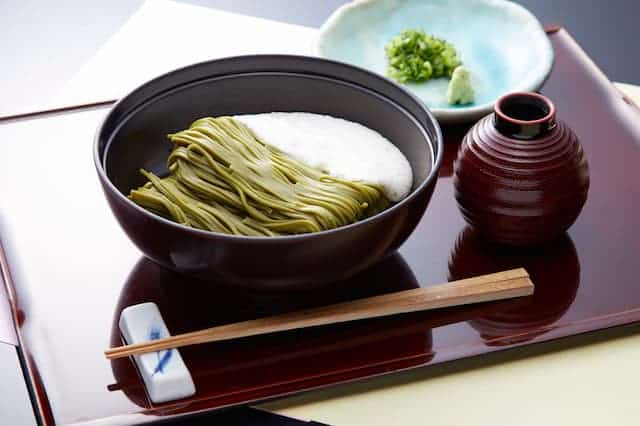
Asakusa is full of Japanese dishes that have been loved since ancient times, such as loach hotpot, sukiyaki, and eel! Located in Asakusa is the long-established Asakusa Mugitoro Main Store, which was founded in 1927. This kaiseki restaurant is famous for the “Mugitoro” in its name. So if you have a chance, how about giving this restaurant a try!



Comments